Post-Transjugular Intrahepatic Portosystemic Shunt (TIPS) Hepatic Encephalopathy-A Review of the Past Decade's Literature Focusing on Incidence, Risk Factors, and Prophylaxis
- PMID: 38202028
- PMCID: PMC10779844
- DOI: 10.3390/jcm13010014
Post-Transjugular Intrahepatic Portosystemic Shunt (TIPS) Hepatic Encephalopathy-A Review of the Past Decade's Literature Focusing on Incidence, Risk Factors, and Prophylaxis
Abstract
Transjugular intrahepatic portosystemic shunt (TIPS) is an established treatment for portal hypertension and its' complications in liver cirrhosis, yet the development of hepatic encephalopathy (HE) remains a significant concern. This review covers the reported incidence, risk factors, and management strategies for post-TIPS HE over the past decade. Incidence varies widely (7-61%), with factors like age, liver function, hyponatremia, and spontaneous portosystemic shunts influencing risk. Procedural aspects, including TIPS timing, indication, and stent characteristics, also contribute. Pharmacological prophylaxis with lactulose and rifaximin shows promise, but current evidence is inconclusive. Procedural preventive measures, such as shunt embolization and monitoring portal pressure gradients, are explored. Treatment involves pharmacological options like lactulose and rifaximin, and procedural interventions like stent diameter reduction. Ongoing studies on novel predictive markers and emerging treatments, such as faecal microbiota transplant, reflect the evolving landscape in post-TIPS HE management. This concise review provides clinicians with insights into the multifaceted nature of post-TIPS HE, aiding in improved risk assessment, prophylaxis, and management for patients undergoing TIPS procedures.
Keywords: ascites; brain dysfunction; cognition; liver cirrhosis; portal hypertension; time trend; variceal bleeding.
Conflict of interest statement
The authors declare no conflict of interest.
Figures



Similar articles
-
Controlled underdilation using novel VIATORR® controlled expansion stents improves survival after transjugular intrahepatic portosystemic shunt implantation.JHEP Rep. 2021 Mar 3;3(3):100264. doi: 10.1016/j.jhepr.2021.100264. eCollection 2021 Jun. JHEP Rep. 2021. PMID: 34013182 Free PMC article.
-
Transjugular intrahepatic portosystemic shunt in cirrhosis: An exhaustive critical update.World J Gastroenterol. 2020 Oct 7;26(37):5561-5596. doi: 10.3748/wjg.v26.i37.5561. World J Gastroenterol. 2020. PMID: 33088154 Free PMC article. Review.
-
Surgical portosystemic shunts versus transjugular intrahepatic portosystemic shunt for variceal haemorrhage in people with cirrhosis.Cochrane Database Syst Rev. 2018 Oct 31;10(10):CD001023. doi: 10.1002/14651858.CD001023.pub3. Cochrane Database Syst Rev. 2018. PMID: 30378107 Free PMC article.
-
[Comparison of the curative effect of transjugular intrahepatic portosystemic shunt with expanded polytetrafluoroethylene-covered stent and drug combined with gastroscopy as the secondary prevention of esophageal -gastric variceal bleeding in portal hypertension].Zhonghua Gan Zang Bing Za Zhi. 2020 Aug 20;28(8):672-678. doi: 10.3760/cma.j.cn501113-20190723-00266. Zhonghua Gan Zang Bing Za Zhi. 2020. PMID: 32911906 Chinese.
-
Long-term clinical outcomes in patients with viral hepatitis related liver cirrhosis after transjugular intrahepatic portosystemic shunt treatment.Virol J. 2018 Oct 1;15(1):151. doi: 10.1186/s12985-018-1067-7. Virol J. 2018. PMID: 30285813 Free PMC article.
Cited by
-
Chinese Guidelines on the Management of Hepatic Encephalopathy in Cirrhosis (2024).J Clin Transl Hepatol. 2025 Mar 28;13(3):253-267. doi: 10.14218/JCTH.2024.00484. Epub 2025 Feb 17. J Clin Transl Hepatol. 2025. PMID: 40078200 Free PMC article.
-
Incidence and efficacy of strategies for preventing hepatic encephalopathy following transjugular intrahepatic portosystemic shunt: A meta-analysis.World J Hepatol. 2025 Apr 27;17(4):104890. doi: 10.4254/wjh.v17.i4.104890. World J Hepatol. 2025. PMID: 40308821 Free PMC article.
-
A new gut-brain therapeutic target for hepatic encephalopathy.Nat Med. 2025 Feb;31(2):386-387. doi: 10.1038/s41591-024-03467-9. Nat Med. 2025. PMID: 39920393 No abstract available.
-
Controlled expansion stent grafts versus legacy stent grafts for transjugular intrahepatic portosystemic shunt: a single-centre retrospective study on the incidence of hepatic encephalopathy.CVIR Endovasc. 2025 May 24;8(1):48. doi: 10.1186/s42155-025-00557-8. CVIR Endovasc. 2025. PMID: 40411691 Free PMC article.
-
Comparative efficacy of pre-emptive TIPS and elective TIPS in EGVB patients with cirrhosis: A single-center retrospective study.Saudi J Gastroenterol. 2025 May 1;31(3):168-175. doi: 10.4103/sjg.sjg_389_24. Epub 2025 Feb 7. Saudi J Gastroenterol. 2025. PMID: 39918030 Free PMC article.
References
-
- Bissonnette J., Garcia-Pagán J.C., Albillos A., Turon F., Ferreira C., Tellez L., Nault J.C., Carbonell N., Cervoni J.P., Abdel Rehim M., et al. Role of the transjugular intrahepatic portosystemic shunt in the management of severe complications of portal hypertension in idiopathic noncirrhotic portal hypertension. Hepatology. 2016;64:224–231. doi: 10.1002/hep.28547. - DOI - PubMed
-
- Gralnek I.M., Camus Duboc M., Garcia-Pagan J.C., Fuccio L., Karstensen J.G., Hucl T., Jovanovic I., Awadie H., Hernandez-Gea V., Tantau M., et al. Endoscopic diagnosis and management of esophagogastric variceal hemorrhage: European Society of Gastrointestinal Endoscopy (ESGE) Guideline. Endoscopy. 2022;54:1094–1120. doi: 10.1055/a-1939-4887. - DOI - PubMed
Publication types
LinkOut - more resources
Full Text Sources
Miscellaneous

